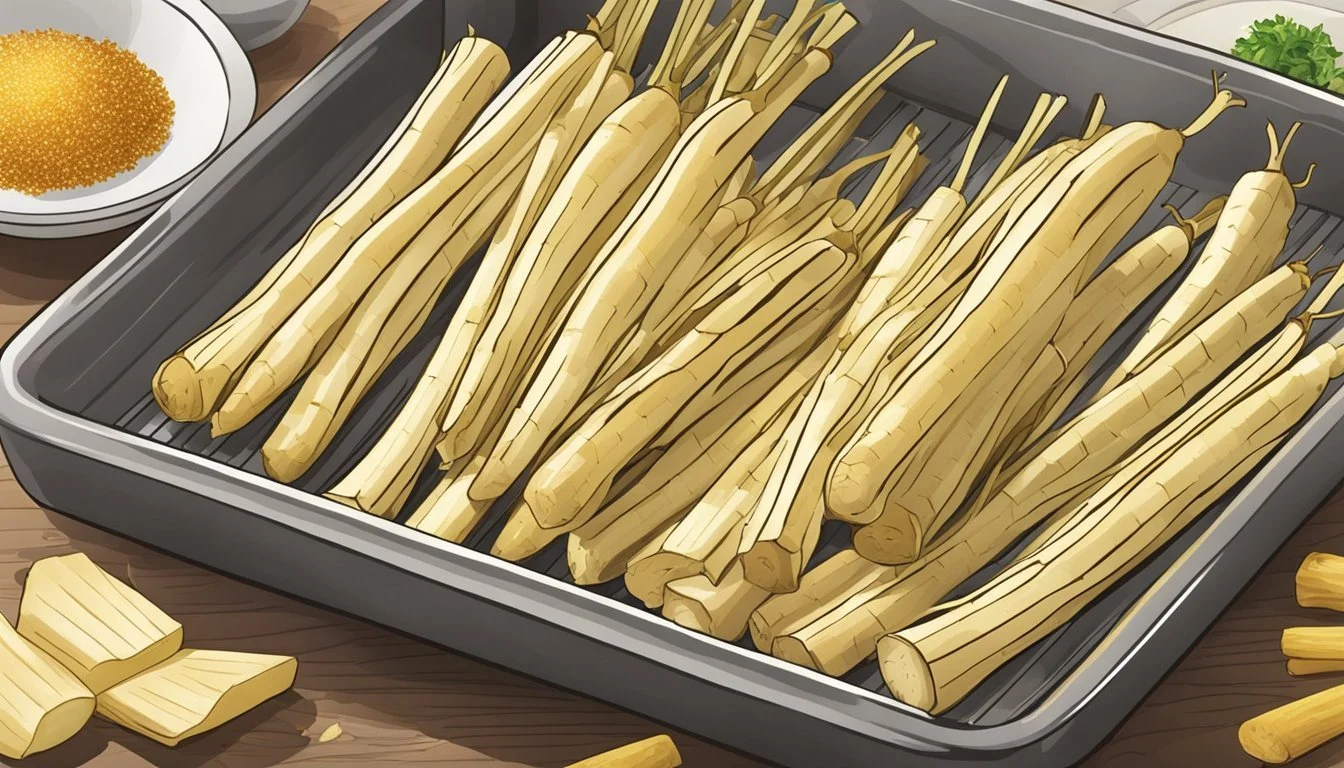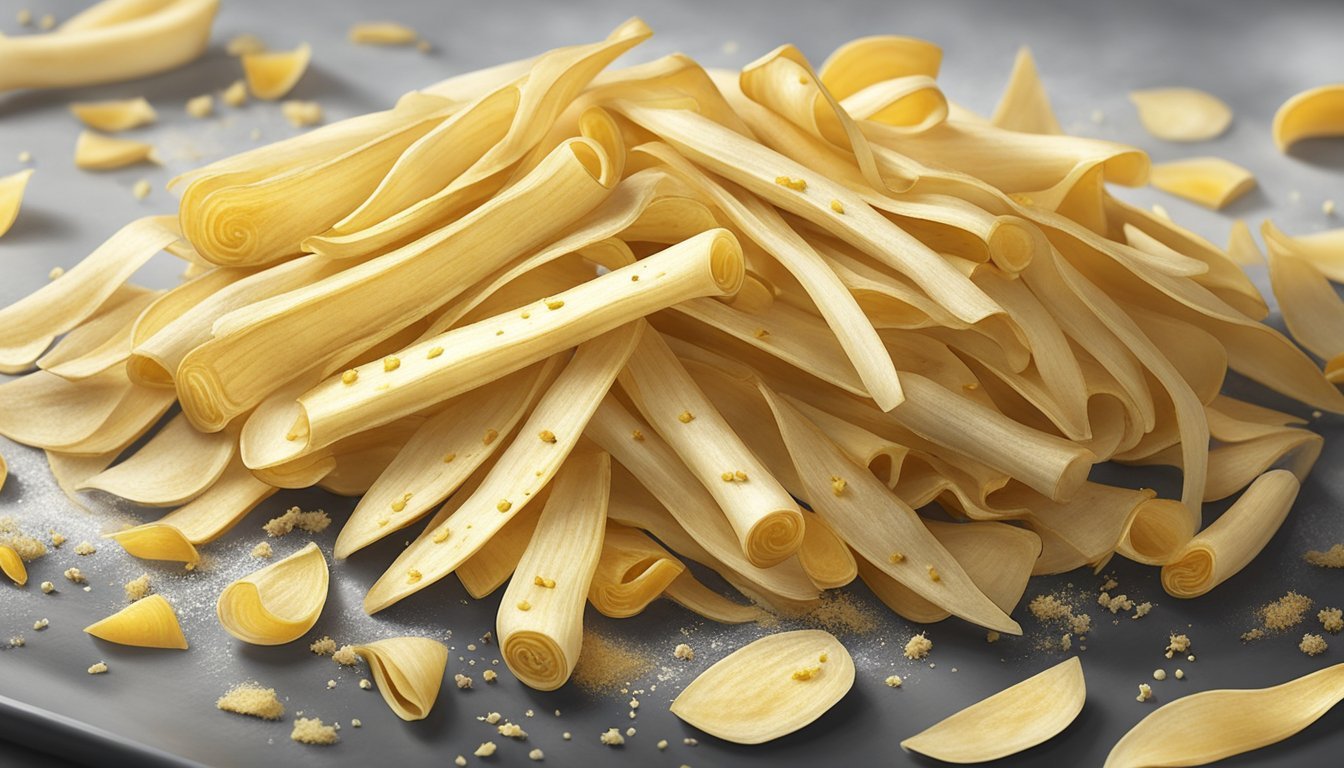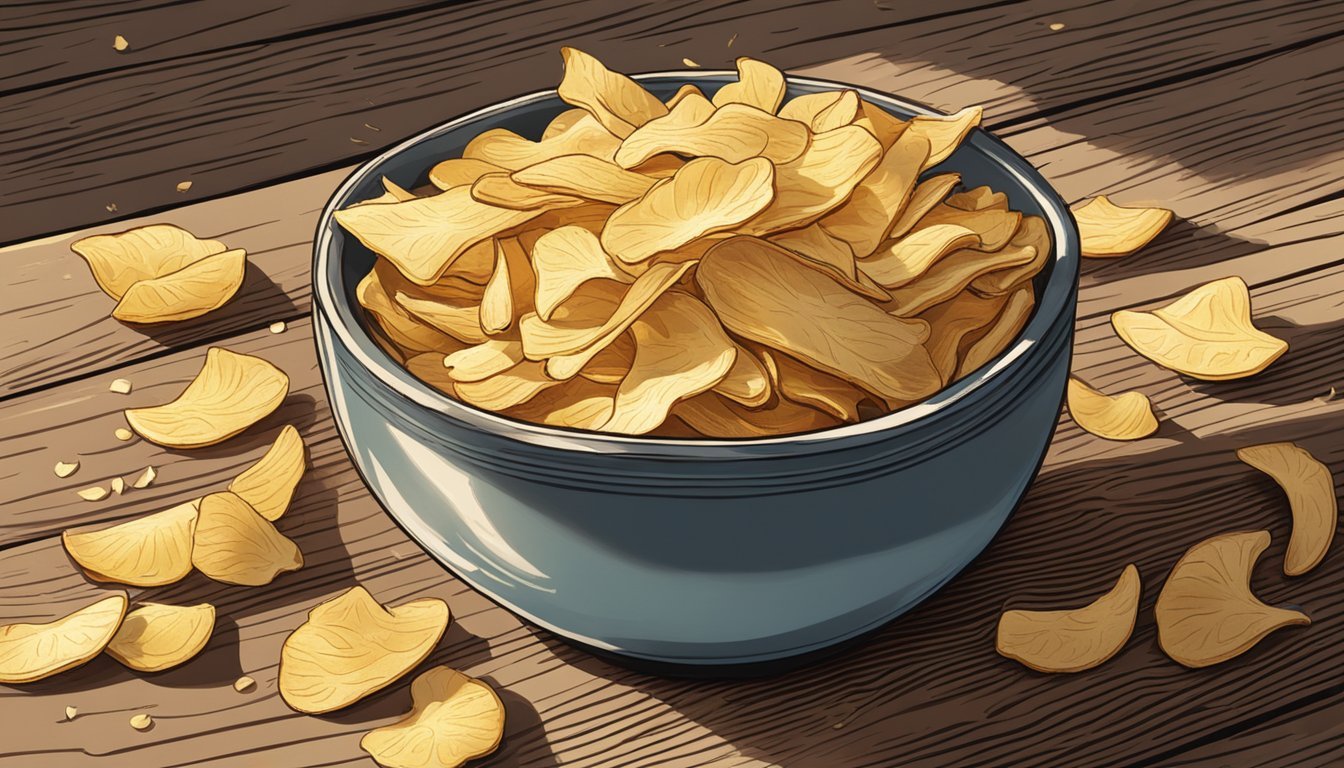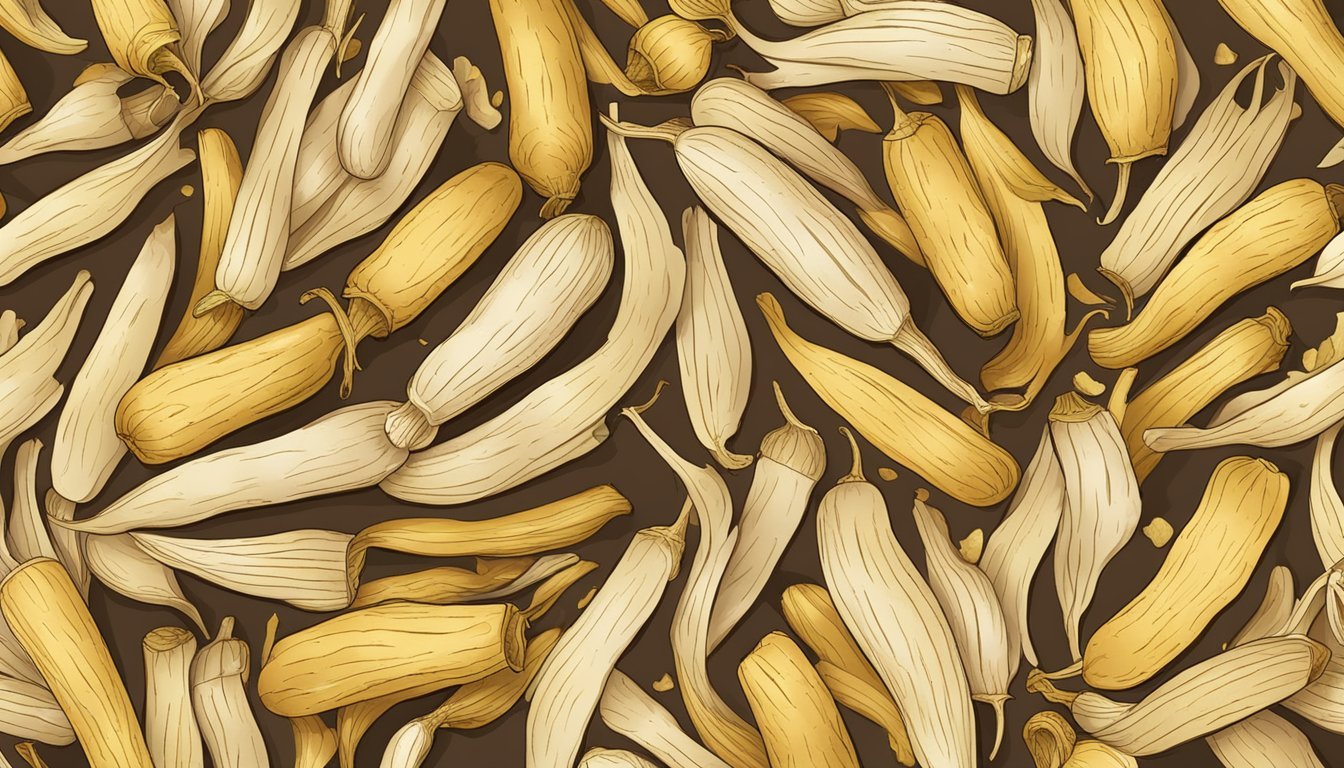Parsnip Peel Crisps
A Sweet, Earthy Snack Revolution
Parsnips, with their sweet, earthy flavor, make for an innovative and nutritious alternative to traditional potato crisps. These root vegetables, resembling an ivory-colored carrot, have been part of human diets for centuries, prized for their natural sweetness that intensifies with cooking. When sliced thin and baked or air-fried to a crisp, parsnips transform into a delightful snack that carries a wholesome edge over the usual fried offerings. These parsnip crisps offer a different experience that appeals to snack lovers seeking something out of the ordinary, yet still craving that satisfying crunch.
The process of turning parsnips into crispy snacks (What wine goes well with snacks?) is straightforward and allows for a range of seasonings to enhance their inherent nutty sweetness. The transformation involves thinly slicing the parsnips and then coating them lightly in oil before they are cooked at high temperatures to achieve the desired crispness. The result is a batch of golden, chip-like morsels that can serve both as a standalone snack or as a crunchy addition to salads and soups.
Parsnip crisps not only stand out for their flavor but are also a healthier option loaded with dietary fiber and essential nutrients. Their preparation does not require deep frying, a cooking technique commonly associated with other crisp snacks, thus reducing the amount of absorbed fat. Snack enthusiasts can enjoy these earthy delights knowing they are choosing a healthier option that does not compromise on taste.
Nutritional Profile of Parsnips
Parsnips are a nutritious root vegetable with a sweet, earthy flavor. They are particularly high in carbohydrates and dietary fiber, contributing to their role in promoting digestive health. On average, parsnips contain 75 calories per 100 grams, making them a low-calorie option suitable for balanced diets.
Macronutrients:
Protein: Parsnips offer a modest amount of protein, with about 1.2 grams per 100g serving.
Fat: This vegetable is low in fat, providing only a trace amount that is negligible in terms of daily intake.
Carbohydrates: Carbohydrates are the primary macronutrient present in parsnips, with 18 grams per 100g serving. After accounting for the fiber, this equates to about 13.1 grams of net carbs.
Fiber Content:
Parsnips are a good source of dietary fiber, with approximately 4.9 grams per 100 grams. Fiber contributes to satiety and aids in maintaining healthy bowel movements.
Minerals and Vitamins:
Magnesium: A cup of sliced parsnips provides over 45 milligrams of magnesium, which is more than 10% of the daily recommended intake for adults.
Calcium: They contain calcium, crucial for bone health, though in smaller quantities compared to magnesium.
Healthy Antioxidants:
Parsnips contain antioxidants that help to protect the body from oxidative stress. Including parsnips in one's diet adds variety and beneficial phytonutrients that can support overall well-being.
Summary Table:
Nutrient Amount per 100g Calories 75 kcal Protein 1.2 g Fat Trace Net Carbohydrates 13.1 g Fiber 4.9 g Magnesium >45 mg (per cup) Calcium Present
Parsnips are a healthy choice for those looking to include more root vegetables in their diet, with a nutritional profile that supports various aspects of health maintenance.
Choosing the Right Ingredients
To ensure your parsnip peel crisps are flavorful and crisp, selecting high-quality ingredients is essential. The right parsnips, oil, and seasonings will elevate this simple snack into a delicious treat.
Selecting Quality Parsnips
When choosing parsnips, look for ones that are firm and free of blemishes or soft spots. Small to medium parsnips tend to be sweeter and more tender. Avoid large parsnips as they may have a woody core, which can affect the texture of your crisps.
Types of Oil for Cooking
The type of oil used can influence the taste and texture of the crisps:
Olive oil: Imparts a rich flavor and is ideal for baking at moderate temperatures.
Sunflower oil: Has a neutral taste and is suitable for higher heat, making it a good option for both baking and frying.
It's important to choose an oil with a higher smoke point to ensure it remains stable during cooking.
Salt and Seasoning Options
Seasonings add depth to the natural sweetness of parsnips. Here's a guide:
Salt:
Sea salt: Enhances flavor without overpowering the parsnips.
Pepper and Spices:
Black pepper: Provides a sharp, spicy note.
Paprika: Adds sweetness and color, with smoky undertones.
Cayenne: Offers heat for those who prefer spicier crisps.
Ground cumin: Gives an earthy touch.
Garlic powder: Delivers a savory kick.
Cinnamon: For a sweet and warm flavor, can be used sparingly.
In summary, choosing quality parsnips, the right oil for cooking, and a thoughtful combination of seasonings will create parsnip crisps that are both delicious and satisfying.
Preparation Essentials
Essential to making parsnip peel crisps is starting with proper preparation of the parsnips and optimizing the use of a mandolin for even, thin slices.
Prepping the Parsnips
The first step in preparing parsnips for crisps involves cleaning the parsnips thoroughly. They should be washed under running water to remove any dirt. While some recipes suggest peeling parsnips, for crisps, retaining the skin can add flavor and nutrients. It's crucial to remove the woody core from larger parsnips, as it can affect the texture of the crisps. Pat the cleaned parsnips dry with a paper towel before slicing.
Optimal Mandolin Use
A mandoline slicer is an indispensable tool for creating uniform, thin slices of parsnip that are essential for crisp, even cooking. To use a mandolin safely, one should always employ the guard to protect fingers from the sharp blade. For the best results:
Set the mandoline to a thin slice setting, typically 1-2mm.
Hold the mandoline steady with one hand and use the guard to slide the parsnip across the blade with the other.
Consistent pressure results in even slices; varying pressure could yield irregular crisps.
Lastly, place the parsnip slices into a large bowl as they are cut for the subsequent seasoning and cooking steps.
Cooking Techniques
Cooking parsnip crisps can be approached in several ways, each varying in texture and flavor profile. Whether baking, air frying, or deep-frying, maintaining the correct temperature and ensuring the parsnips are in a single layer are crucial steps in achieving a crisp outcome.
Baking Parsnip Crisps
Baking is a straightforward method, requiring an oven preheated to around 150°C/300°F. Here's how to bake parsnip crisps:
Peel the parsnip into thin strips and toss them in cooking oil, seasoned with salt and pepper.
Spread the strips on baking trays in a single layer to ensure even cooking.
Bake for 10-15 minutes, checking regularly until they are golden brown. It's important to turn them halfway through cooking to ensure even crispness.
Using an Air Fryer
Air-fried parsnip chips offer a healthier alternative to deep-frying while still delivering on crunch. Follow these steps:
Preheat the air fryer to 375°F (190°C).
Arrange the parsnip strips in a thin, even single layer in the fryer basket.
Cook for 5 minutes, flip the chips, then cook for an additional 5 minutes. Add more time if needed, depending on the thickness of the parsnips.
Deep-Frying Method
Deep-frying yields extra-crisp results and is perfect for those who crave a traditional crunchy texture. For this technique:
Heat the cooking oil in a deep fryer or pan to 375°F (190°C).
Use a slotted spoon to carefully lower the parsnip ribbons into the hot oil.
Fry for about 2 minutes until golden and crisp, then remove and drain on paper towels.
By following these cooking techniques, one can create parsnip crisps that are a delightful combination of sweet and earthy flavors, (What wine goes well with earthy flavors?) perfect for snacking or as a garnish.
Flavor Enhancements
When making parsnip peel crisps, the right combination of seasonings can elevate this snack from simply tasty to remarkably flavorful. One should consider balancing the natural sweetness and earthiness of parsnips with complementing spices and herbs for a more dynamic taste.
Herbs and Spices
Salt and Pepper: Fundamental to most recipes, a pinch of salt and black pepper can bring out the inherent flavors of parsnip crisps.
Sweet Spices:
Cinnamon: A light dusting adds warmth and complements the parsnip's sweetness.
Ground Cumin: Provides a nutty and peppery layer that pairs well with the vegetable's earthy profile.
Spicy and Savory Twists:
Paprika: Offers a mild heat and vibrant color.
Cayenne: A small amount can give a spicy kick for those who favor heat.
Garlic Powder: Introduces a savory note, which contrasts nicely with the parsnip's sweetness.
Dips and Accompaniments
Olive Oil: It's not just for preparing the crisps—olive oil can serve as a base for flavorful dips.
Dip Varieties:
Herby yogurt dip: A blend of Greek yogurt with dill, parsley, or chives can complement the crisps with a creamy texture and fresh taste.
Aioli: Elevate with garlic powder or fresh garlic to create a rich and bold accompaniment.
Substitutes and Alternatives:
Instead of traditional dips, one might opt for a balsamic reduction or even a sprinkle of vinegar to add a tangy contrast to the sweet and earthy flavors of the crisps.
By incorporating a thoughtful selection of herbs, spices, and accompaniments, one can greatly enhance the gustatory experience of parsnip peel crisps.
Post-Cooking Tips
Once the parsnip peel crisps have completed their cooking cycle, achieving the perfect texture and flavor, attention must turn to their presentation and storage to preserve their delightful crunch.
Serving Suggestions
For optimum enjoyment, serve parsnip crisps immediately after cooking, when they're at their crispiest. Serving size per person should be about a handful since they are rich in flavor and perhaps accompany them with a dip like hummus or a tangy yogurt sauce for balance. For a sweet twist, a sprinkle of cinnamon can complement the earthy tones of the parsnips.
Proper Storage Techniques
If there are leftovers, it's critical to store them correctly to maintain their crispness. Place the cooled parsnip crisps in an airtight container with a piece of paper towel to absorb any excess moisture. They can also be stored in the fridge like this for 3-4 days. To reheat and bring back the crispness, simply lay them out in the air fryer at 390° F for 3-5 minutes, watching carefully to avoid burning.
Healthy Snacking
When searching for a satisfying munch, Parsnip Peel Crisps stand out as a nutritious choice. They offer a delightful crunch and an earthy sweetness that caters to various dietary preferences, encompassing vegan and paleo lifestyles.
Diet Inclusions
Vegan: Parsnip Peel Crisps are inherently vegan-friendly, made entirely from plant-based ingredients. As a healthy snack, they fulfill the need for a crispy bite without relying on animal products.
Paleo: Adhering to a paleo diet means focusing on whole foods that could have been obtained by our hunter-gatherer ancestors. Parsnips are paleo-compliant, and when baked into crisps, they make for a perfect paleo snack.
Fiber: A single serving of parsnip crisps contributes significantly to the recommended daily intake of fiber. Fiber is essential for digestive health and can help keep you feeling full longer.
Nutrients: Parsnips are a good source of essential vitamins and minerals. They offer more than just fiber; they also contain notable amounts of protein, which is crucial for muscle repair and overall health.
Recipe Variations
When crafting parsnip crisps, one has the flexibility to adapt the dish to their palate or dietary requirements. The following variations bolster the basic recipe, transforming it into a tailored snack or side dish.
Creative Twists
Spice Infusions: Incorporate spices like smoked paprika, garlic powder, or rosemary during preparation to infuse parsnip chips with robust flavors.
Herb Enhancements: Fresh herbs such as thyme or rosemary can be finely chopped and sprinkled onto the parsnips before baking or frying, lending a fragrant aromatic touch.
Suggestions for Substitutions
Sweet Potato Alternative: For those seeking diversity or catering to specific tastes, sweet potatoes can readily substitute parsnips, yielding a sweeter yet similarly textured crisp.
Cooking Method Variations:
Oven-Baked Chips: Utilize an oven set to a moderate temperature, around 375°F (190°C), to achieve a crisp texture without added oil.
Air Fryer Parsnips: An air fryer offers a quick and less oily method of cooking, producing crisp parsnips with a light and airy texture.
Fried Parsnips: Deep-frying in oil can be utilized for an indulgent, crisper variant, ideally at a temperature of 375°F (190°C) for uniform cooking.
Health-Conscious Choices: For a lower-calorie option, parsnips can be thinly sliced and baked without oil, creating a lighter version of the traditional vegetable crisp.
By incorporating these variations, parsnips crisps can serve as a versatile dish suitable for myriad occasions, from a casual snack to an elegant side dish or even an unconventional dessert.
Community Engagement
Engaging with the community is vital in spreading the appeal of Parsnip Peel Crisps. Social media platforms offer the perfect stage, while feedback is the cornerstone of improvement and community building.
Sharing on Social Media
Sharing recipes and experiences with Parsnip Peel Crisps on platforms like Pinterest, Facebook, Instagram, and Twitter creates visibility and inspires others to try this unique snack. Users can post photos of their homemade crisps, using specific hashtags such as #ParsnipCrisps or #HealthySnacking to increase the reach of their content. Here's a simple structure they can follow:
Post an image or video: A visually appealing photo or a quick tutorial on making the crisps.
Use hashtags: Include relevant hashtags to join the broader conversation.
Tag friends: Encourage friends to try the recipe and challenge them to post their own creations.
Encouraging Feedback
Feedback is essential for refining recipes and understanding consumer preferences. Encouraging users to leave a comment or star rating on the recipe can provide valuable insights for both the recipe sharer and those looking to try it out. Feedback can be prompted in several ways:
Ask direct questions: What did you like about the parsnip peel crisps? How can the recipe be improved?
Engage with comments: Respond to comments to show appreciation and foster a responsive community.
Star ratings: A quick and easy way for others to gauge the popularity and quality of the recipe.









